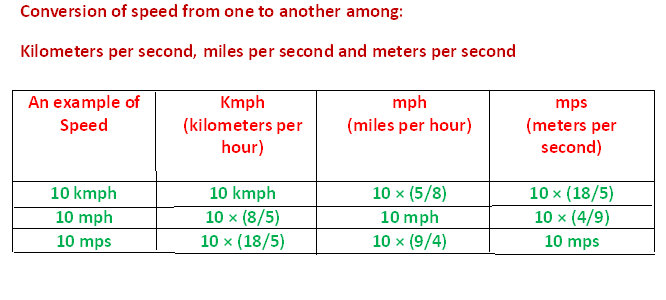Math-for-all-Grades
Time and Distance
Let d, s and t denote distance, speed and time respectively. Then,
Distance is product of speed and time, i.e.
1. d = s × t,
in which d is distance, s is speed and t is time.
Example:
The distance travelled by a bus running at an average speed 50 mph for 4 hours is
50 × 4 = 200 miles.
Similarly, speed is distance over time, i.e.:
2. s = d/t
The average speed of a car that has travelled:
100 miles in 2 hours is 50 mph (miles per hour)
Again, time is distance over speed, i.e.
3. t = d/s
Example:
The time a car will take to cover 100 miles at an average speed of 40 mph is
100/40 = 2.5 hours.
4. Conversion of Units:
1 kilometer = 1000 meters and 1 hour = 3600 seconds.
Therefore:
1km/hr = 1000m/3600s = 5/18 m/s or 5/18 ms-1
{Km/hr is read as kilometers per hour and m/s is read as meters per second)
Example:
The speed of a train is 190 km/hr. find the speed in m/s (i.e. meters per second)
Solution: 180 km/hr = 180 × (5/18) m/s = (180 × 5)/18 = 10 × 5 = 50 m/s
5. Similarly, as in point no. 4 above:
1 m/s = 18/5 km/hr
1 mph = 8/5 kmph
{mph is miles per hour and kmph is kilometers per hour and 1 mile is 8/5 kilometer}

Example:
A city bus travels at an average speed of 20 m/s (20 meters per second). Express the speed in km/hr (kilometers per hour)
Solution:
20 m/s = 20 × 18/5 = (20 × 18)/5 = 4 × 18 = 72 km/hr.
Time and Speed are inversely proportional.
Consider two places separated by a distance of 100 miles.
a. a car will take 4 hours to cover 200 miles at an average speed 50 mph.
b. another car will take 5 hours to cover 200 miles at an average speed of 40 mph.
Ratio of speeds of the two cars = 50: 40 = 5: 4, and the
Ratio of times taken by the two cars = 4: 5, i.e. inverse of the ratio of speeds.
Two Very Important Rules on Time and Speed:
1. If speed increases K times, then new Time is T/K, where T is the original time taken to cover a same distance.
2. If the ratio of speeds of two cars is x: y, then the ratio of the times taken by them is y: x to cover a same distance
Example 1:
A car takes 9 hours to cover a distance of 500 miles. What time will it take to travel 500 miles if its speed grows 1.5 times the previous speed?
Solution: 1.5 = 3/2
If speed increases 1.5 times, i.e. 3/2 times, then time will decrease proportionately.
So, new time will be 2/3 times of previous time.
Therefore, new time taken is 9 × 2/3 = (9 × 2)/3 = 3 × 2 = 6 hours.
Example 2:
Driving at 5/6 th of his usual speed, John is late to his office by 15 mins. Find the usual time John takes to reach his office.
Solution:
Since, speed and time are inversely related, therefore
If new speed is 5/6 of original speed, then
New time is (6/5) normal time.
Since, John is late to the office by 15 minutes, therefore
(6/5)T ― T = 15, i.e. (1/5) T = 15 {T denotes normal time}
Therefore, T = 15 × 5 = 75 minutes.
So, john normally takes 75 minutes to reach his office.
Average Speed:
If two equal distances are travelled at speeds x mph and y mph, then the average speed over the entire distance is

But, average speed is not average of the two speeds, i.e average speed is NOT:
(x + y)/2
Example 1:
While going from A to B, the speed of a car is 40 mph and 60 mph while coming back from B to A, traveling the same distance. What is the average speed of the car over the entire distance?
Solution:
Since the distance traveled with different speeds is same, the average speed of the car over the entire distance is
(2 × 40 × 60)/ (40 + 60) = 4800/100 = 48
Therefore, average speed over the entire distance is 48 mph.
Note: What Average Speed is NOT?
Average speed is not (40 + 60)/2 = 100/2 = 50 mph.
Average speed is not average of the two speeds, because time taken to travel each equal distance is different as speed is different.
Solved Examples on Time, Speed and Distance:
Example 1:
A car travels at a speed of 45 mph. What is the distance in meters the car will travel in 2 mins 30 seconds?
Solution:
45 mph = 45 × (8/5) kmph = (45 × 8)/5 = 72 kmph
72 kmph = 72 × 5/18 = (72 × 5)/18 = 20 mps {meters per second}
2 mins + 30 seconds is = 120 + 30 = 150 seconds.
Now, d = s × t,
Therefore, distance traveled in meters is:
20 × 150 = 3000 meters.
Example 2:
One car A completes one round of a circular path of radius 1.4 miles in 220 seconds, while another car B travels the diameter of the same path in 280 seconds. Find the ratio of the speeds of the two cars.
Solution:
Circumference of a circular path is 2∏r and since ∏ = 22/7
Speed of car A = d/t = (2 × ∏ × 1.4)/220 = (2 × (22/7) × 1.4)/220 = 0.04 miles per second.
Speed of car B = d/t = (2 × 1.4)/280 = 0.008
Therefore, the ratio of the speeds of the two cars is :
0.04: 0.008 = 5: 1




